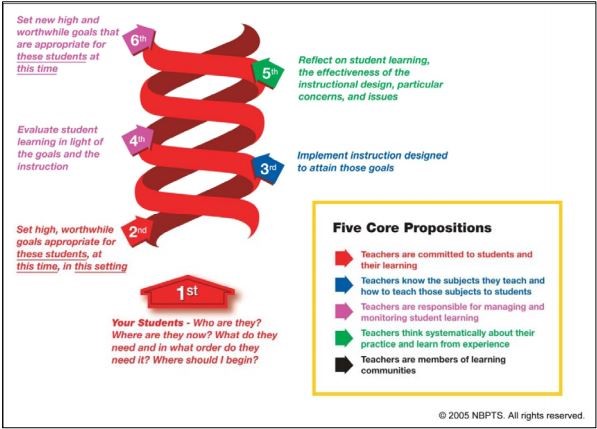Earning my National Board Certification was a professional turning point for me, as it was for many teachers I know. It was early in my career when I submitted my Blue Box (with VHS tapes!), but as soon as I connected with the community of National Board Certified Teachers (NBCTs) here in Washington state, hallways filled with doors of opportunity opened to me.
As I’ve navigated through these new doors, my role has shifted from teacher of teenagers to teacher of fellow teachers and administrators. Stepping into this uncharted territory, I found that the skill set I brought as an accomplished classroom teacher felt at odds with this new world leading adult learning.
 It shouldn’t have, though. Now five years into leading the learning of my peers, it is clear that the Architecture of Accomplished Teaching transfers in many ways, helping to guide my design of effective adult learning. While the parallels between pedagogy and andragogy do have limits, I believe that some of those dreadful PD experiences we’ve all endured (and about which Patrick Ledesma wrote) could have been dramatically improved by a little bit of that Architecture.
It shouldn’t have, though. Now five years into leading the learning of my peers, it is clear that the Architecture of Accomplished Teaching transfers in many ways, helping to guide my design of effective adult learning. While the parallels between pedagogy and andragogy do have limits, I believe that some of those dreadful PD experiences we’ve all endured (and about which Patrick Ledesma wrote) could have been dramatically improved by a little bit of that Architecture.
At the base of the familiar helix are the students–and for the Architecture of Accomplished Teaching of Teachers, the questions are the same: Who are they? Where are they now in their learning? What do they need and in what order do they need it? Where should I begin? The foundation of good instruction is knowing the learner and basing decisions on formative assessments–two elements of good instruction that sometimes don’t appear to be considered in teacher PD design.
I understand why this is missing, though: A workshop facilitator tends to bring in a predetermined slide deck on a pre-established topic. It seems that seldom is meaningful formative assessment, or even the opportunity for getting to know the actual needs of the learners, built into teacher PD experiences. But it can be done: sometimes as simply as asking teachers what they need and then being a nimble enough teacher to monitor and adjust in the moment for the needs of the learners.
For example, some of my most successful PD sessions have started with me saying, “This morning you came to learn about X: Take a moment to jot down what you most hope to get out of our time together.” I then collect and review the responses while participants engage in a brief reading or video clip to build common schema, and adapt my plans to better address the priorities identified by simply asking what people need. We expect this same kind of enacting-on-the-spot of ourselves in our classrooms, and we can certainly model it in our teacher-leadership.
Moving up the helix, accomplished teachers design instruction aimed at attaining goals. Just like in my classroom, where I must have in mind what I want my students to do with the information I give them, professional gatherings of teachers ought to have clear goals for outcomes. When we walk out with the familiar “this could’ve been an email” feeling, our time has been wasted. When we walk out with a to-do list, passive recipients of new boxes to check, that’s not ideal either. The best situation is when we acquire new knowledge that we can apply to better serve our kids. It is such a great feeling to leave a meeting or workshop invigorated instead of frustrated. And if, on top of that, we can learn about instruction by watching how a skilled teacher facilitates our learning in a training or meeting… then we’re in PD heaven. Too often, it feels like the opposite.
It was actually that next stage of the helix, reflection, that helped me make the connection between teaching and leading. My first time leading PD for my peers, I received a canned PowerPoint and followed instructions to present its contents. My colleagues, many of whom I’d worked alongside for a decade, were snapping pictures of each other falling asleep and posting them on Facebook. At least they tagged me, so it was all in good fun.
As that afternoon wrapped, my teacher-brain was exploding: never would I have tolerated such awful instruction from myself in front of my high schoolers, so why did I permit myself to “teach” that way in front of my peers? I made a resolution to never again treat teacher PD like something to “get through.” Just like in my own classroom, I wanted my learners to walk out wanting more. In the five years since that horrible first workshop, I’ve worked hard to ensure that every learning experience I craft for teachers would pass muster in my own classroom of kids.
The Architecture of Accomplished Teaching, when applied effectively, results not only in better learning, but also engagement. The same can absolutely be true when working with adult learners. In the teacher-leader roles we often find ourselves in as NBCTs, it is worth remembering those skills that made us accomplished teachers in the first place…and to bring those skills to the fore when we stand in front of our peers.
